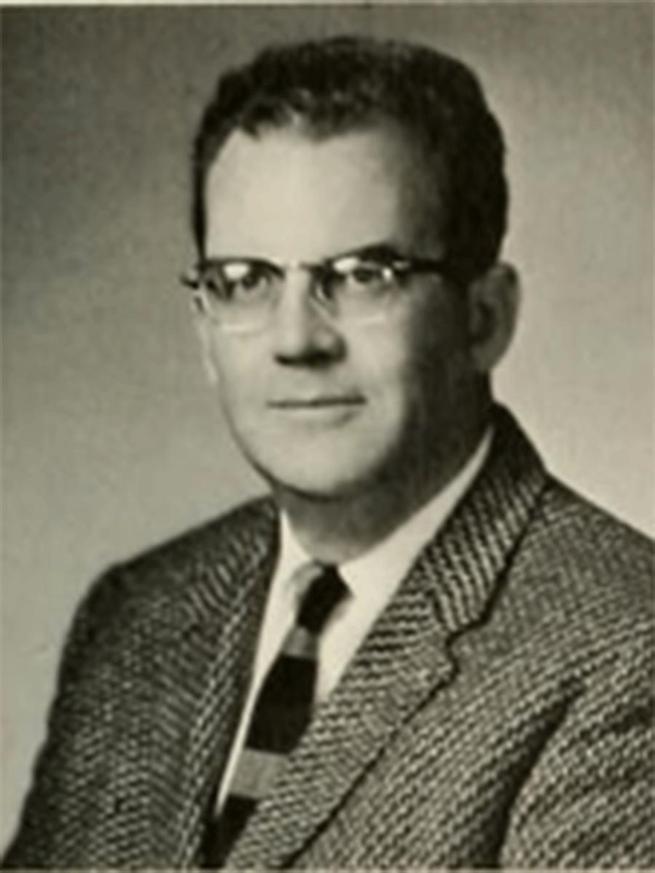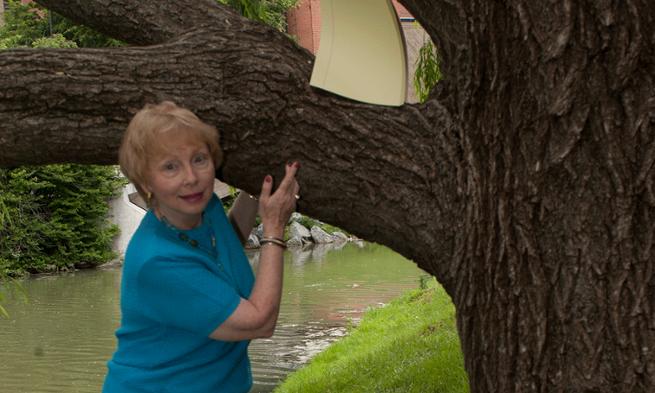Elmer Smith
Professors We Love
What you can learn from a professor up a tree
By Jane Garrett Marshall ('61)
This is just one of many stories from Madison magazine's award-winning Professors You Love series, written by JMU students and alumni, about the professors that have made the most impact on their lives — then, and now.
College, I was forewarned, meant elephantine textbooks, rapid note taking, library research papers and brain-defying tests and exams. My freshman year I walked into Principles of Sociology, where I met a professor who disproved all I'd been told. College was much more than books, papers and grades. Dr. Elmer Smith taught me that college was about life.
"Through Dr. Smith, I began to view education as face-to-face experiences with people, places and events. ... He had me hooked on the world as a classroom."I cannot tell you fact-for-fact what I learned that semester or year-by-year as I took every course Dr. Smith taught. I can tell you he reinforced my sense of curiosity and validated my belief that people matter. In sociology classes, Dr. Smith discussed a group of people whose name I had only heard of, but knew nothing about — the Amish. He spoke of visiting them and the questions he asked. He took notes, taped conversations and wrote books about them.
Through Dr. Smith, I began to view education as face-to-face experiences with people, places and events. Following his example, I carried a notepad, recorded observations and kept an open mind about people of different races, cultures and religions. Before Dr. Smith, I witnessed that character trait in my parents; but this was college, where there were right and wrong answers that many students equated to right and wrong races, cultures and religions. Unlike other professors I had, Dr. Smith was bias-free. He delighted in being a door that opened into new vistas of learning. I'm sure he chuckled under his breath as he gently turned the key that opened students' minds. His acceptance of differences among students and the cultures he researched set a model for us as future teachers.
In his Social Problems course, he introduced naive '50s college girls to a world few of us knew. His stories of New York City's Lower East Side Bowery were eye-opening. He spoke with compassion about alcoholics. I was shocked to learn a Bowery alcoholic he called "Doc" had a doctorate. We became aware that all people have problems.
One beautiful spring day in Community Organization, parade music resounded through open windows. He heard his students say, "Oh, let's go to the parade." He firmly shook his head. His yellow legal pad glistened with notes. I said, "But Dr. Smith, shouldn't we go interview parade watchers? We should find out if and how this parade supports organizations within the community." His stern face softened as he tried hard to stifle a laugh. He picked up his legal notepad, walked to the door, turned and said, "Class dismissed." We cheered as Dr. Smith walked out muttering, "What have I created?" At the next class I surprised Dr. Smith with my parade interview results. He had me hooked on the world as a classroom. I sought opportunities to emulate research techniques.

During my junior year, an unexpected event presented, what I considered, the chance of a lifetime. Word spread like snow flurries in a blizzard that the recently deceased Rev. Fry was going to return to complete his earthly mission. His widow, it was said, had received an omen while eating blueberry pie. The juice in the plate, a source said, separated and transformed into a cross. According to the word on the street, Mrs. Fry said, "I've received a vision. Rev. Fry is coming back. He will arise from the grave." The news was soon broadcast all over campus.
I panicked. How was I going to get to the cemetery to witness this event? This was sociology and anthropology — not just textbook learning — I had to be there. I was "Smithite."
In the 1960s, students were not allowed to leave the dorm until 7 a.m. unless they worked in the dining hall. That concerned me greatly. I worried that the Rev. Fry might resurrect before 7 o'clock. I'd miss an historic event. Another concern was that students weren't allowed to have cars. Clusters of students talked excitedly. I knew the topic of discussion: "How are we going to get a car?"
A fellow agreed to take a carload of girls to the cemetery. I hoped the Rev. Fry would not appear before our arrival. Apple Blossom Festival attendants in Winchester (about a two-hour drive away) got word of the story on a radio station. Later, the newscaster reported, the event created the biggest traffic jam Rockingham County roads had ever experienced. Cars outnumbered turkeys, chickens and cows.
When I arrived at the crowded cemetery, I gazed through the morning fog at people huddled together. I glanced toward the sky for an omen. There I saw, perched up in a tree, Dr. Smith with pen and notepad propped up on a branch. With him in the tree was his sidekick, Latin professor Mr. Stewart. I watched them silently observe the crowd.
The Rev. Fry did not rise from the grave. The widow, it was reported, said that it was because there were so many "disrespectful unbelievers present." A number of people camped out in the cemetery the night before. Beer and soda cans and food trash rested against tombstones. I overheard a friend of the Fry family say, "Rev. Fry wouldn't come back among such heretics." Disappointed students departed, but I left enlightened. My professor, who lived in the world, not in a textbook, was up a tree. And I was there.
The spirit of adventure nurtured by Dr. Smith motivated me — as a teacher — to apply for Washington Post grants, which enabled me to bring diversity into my classroom. My students met retired Pullman porters and 102-year-old Rosina C. Tucker, the first secretary/treasurer of the Women's Auxiliary of the Brotherhood of Sleeping Car Porters. They also met Benjamin McLaurin, who worked closely with A. Philip Randolph to organize the 1963 Civil Rights March. Because of Dr. Smith's influence, my seventh-grade students learned history through people who made history. I wanted my students to discover, as I had, that education is much more than a textbook. It is an adventure. I learned that from a professor up a tree.
About the professor
The late Elmer Smith taught sociology and anthropology in the 1950s and 1960s and also served as head of the department.
About the author
Jane Garrett Marshall ('61) retired from Fairfax County public schools and served as learning styles consultant. She is an educational tour guide and leads groups through the Amish country. "I tell students there's another story here — a story about Dr. Smith, who made learning an adventure," she says. Marshall earned her master's in geographic education from the University of South Carolina. She and her husband, Bob, live in Florida and are active in Treasure Coast Toastmasters International.
